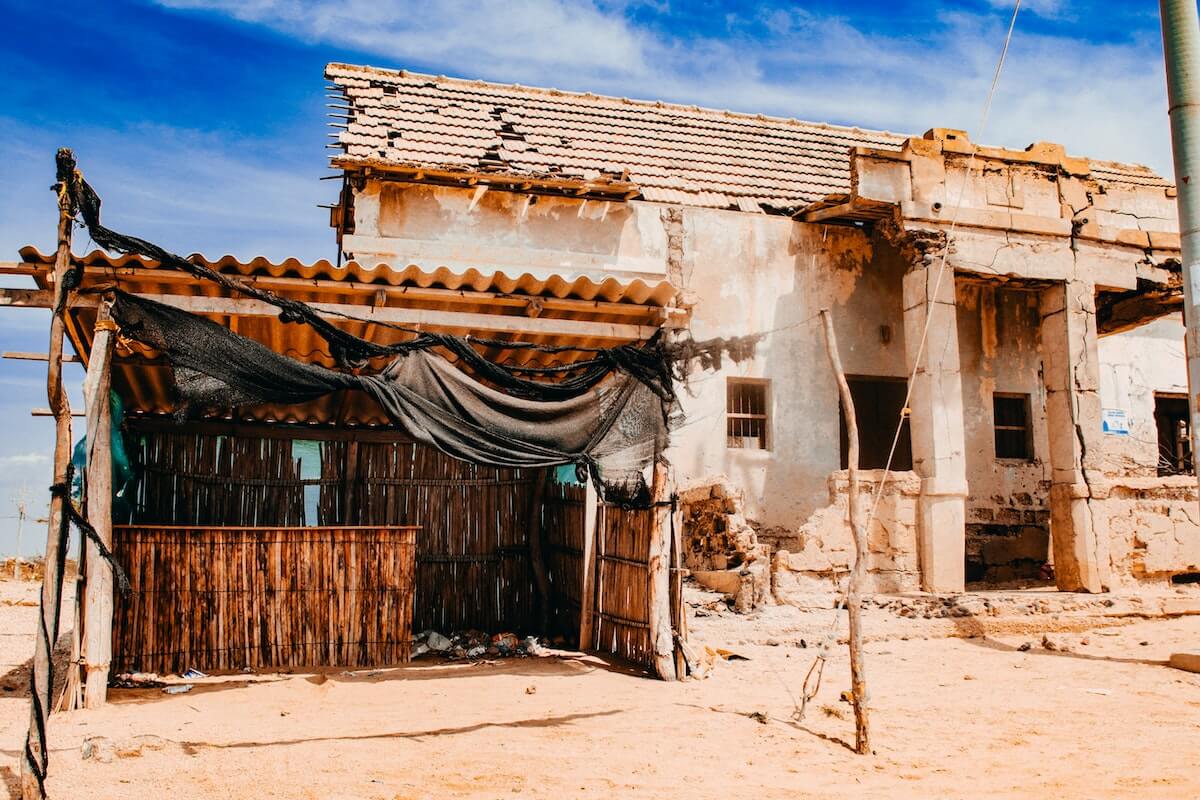Officer Rama and the Mobile Brigade Corps are trapped in a small apartment of a 30-floor building, under siege from its bloodthirsty tenants.
They hear footsteps.
The mob upstairs has broken through the makeshift barricade. They are about to drop down the hole in the ceiling.
Spotting the threat, an officer breaks into a full sprint. He catches a falling thug in mid-air and rams him straight through a 6th-floor window.
That’s the tone of the breathless, brutal action in Gareth Evans’s The Raid: Redemption (2011).
This movie hits so hard they should ship an oxygen mask with the Blu-Ray.
One part high-octane martial arts film, one part survival horror (sans zombies or the supernatural), many action fans rank The Raid among the most influential films in the genre.
And despite the hype, it leaped straight over my expectations.
But it isn’t a tasteless high body count or tacky blood splatters that makes it a must-watch. It’s over the top but grounded in gritty, desperate realism.
Along with the all-out pacing and some of the best hand-to-hand fighting captured on film, the skilled filmmaking here deserves recognition.
And The Raid was made for a little over $1 million U.S. dollars, about 0.5% of the budget of your average Marvel movie.
So is The Raid: Redemption a good movie?
Note: This review is for The Raid: Redemption, released in the U.S. by Sony Pictures Classics, not the original Indonesian release of The Raid.
I believe the expanded title and new soundtrack by Mike Shinoda and Joseph Trapanese are the only differences.
The Plot of The Raid: Redemption:
In the slums of Jakarta, criminal overlord Tama Riyadi (Ray Sahetapy) operates a 30-floor apartment building that acts as a safe haven for the city’s worst thugs and gangsters.
Rookie Brimob member Rama (Iko Uwais) and the rest of a 20-man squad, led by Sergeant Jaka (Joe Taslim) and Lieutenant Wahyu (Pierre Gruno), launch a surprise raid to take Tama down.
When Tama discovers the police have infiltrated his building, he offers a reward to any of his tenants who help him dispose of the invaders.
With their cover blown, no backup in sight, and a small army of thugs raining down on them, Rama and his teammates’ only option is to fight their way out.
The Rest of the Main Cast Includes:
- Yayan Ruhian as Mad Dog
- Donny Alamsyah as Andi
- Iang Darmawan as Gofar
- Tegar Satrya as Bowo
- Eka Rahmadia as Dagu
- Alfridus Godfred as leader of the machete gang
- Henky Solaiman as Rama’s Father
- Fikha Effendi as Rama’s wife
- Verdi Solaiman as officer Budi
- Ananda George as Officer Ari
- Yusuf Opilus appear as Officer Alee
The Good Things:
Pencak Silat and Mixed Martial Arts Choreography, +10 Points
Tony Jaa’s furious knee and elbow strikes in the classic Ong-Bak: Muay-Thai Warrior (2003) forever demonstrated the power and beauty of Muay-Thai (and probably raised enrollment in
kickboxing classes everywhere).
Similarly, The Raid is a showcase for a mix of Indonesian martial arts known as Pencak Silat.
The main character, Rama, and Tama’s muscle, Mad Dog, primarily fight with Pencak Silat. They fire exhilarating kicks, punches, grappling, and knife fighting.
But rather than confining itself to one martial arts discipline, the choreography is fluid. Fighting techniques shift based on the character or the space they occupy.
For example, as actor Joe Taslim was a real-life Judo champion, his Sergeant Jaka adopted a grappling style to his combat.
And in the freewheeling carnage of the drug lab scene, Officers Rama, Dagu, and Wahyu fearlessly rampage through the area like a wrecking ball, steamrolling the goons who run it using Pencak Silat, Taekwondo, and a brawling style, respectively.
Led by lead actors Uwais and Ruhian, the meticulous fight choreography, natural to each character, adds to the realism in the film and creates a more diverse spectacle for the audience.
And it looks like it hurts. All the time.
Nobody was Kung-Fu Fighting, +3 Points
With its realistic approach, The Raid sets itself apart from many classic martial arts movies.
Opponents are attacking each other, not dueling.
The classic tropes are missing. Nobody has a bearded master they hope not to disappoint, a corny super secret move, or wants to prove Crane Style will overcome Tiger’s Paw.
There is no Yuen Woo-ping artful wirework (Crouching Tiger, Hidden Dragon) or stylized gun-fu a la John Woo (Hardboiled).
Martial arts are employed out of desperation, as a means of survival – and it’s anything goes. Characters smash, stab, or fling each other with or into anything they can find.
And it largely swerves the martial arts cliche of twenty people attacking the hero but only one at a time so they can defeat them all.
The behind-the-scenes production blog mentions that, unless a character on camera is down and injured, they’re in the fight.
And our heroes do something pretty novel in action films — they run away sometimes.
Intense Sequences and Frantic Pacing, +4 Points
Whether it’s an exhilarating car chase or an unforgettable fistfight, the best action films make trademark sequences their audience will remember (think the lobby shootout in The Matrix).
The Raid has some particularly memorable segments, which are still rattling around my brain.
The hole drop apartment firefight is straight out of the madcap ending to Leon: The
Professional.
Snipers guard the windows, tenants bum rush the door, and the only escape is chopping through the floor with a fire ax — only to find more feisty tenants below.
We get bits of Oldboy-style hallway fighting, with a cornered Rama taking on a small hit squad.
And there’s the horror-movie machete gang chase, our heroes hiding a hair’s breadth away as the gang stalks the halls.
And other than a few breaks in the conflict, it’s at full throttle the entire time.
I ended the movie so worn out I needed a nap but so full of adrenaline I wanted to run ten miles.
Handheld Cameras and Documentary Film Style, +3 Points
To propel its realistic feel, director/editor Gareth Evans and crew shot and edited The Raid to resemble a documentary.
We follow the action of Rama and his teammates in an up-close-and-personal way, and the camera and editing don’t draw attention to themselves. You won’t find slow-motion Bullet Time (The Matrix) or stylized camera effects here.
To shoot the film, the crew used handheld cameras with the assistance of Fig Rigs to keep things stable.
Sometimes handheld cameras send a movie straight to my naughty step. They can be a big no-no because they make the dreaded (gulp) shaky cam movie.
Thankfully the camerawork is nimble and steady, swiveling with the action without bumping around.
Few Cuts in the Action, +3 Points
You know those martial arts movies where the camera cuts so many times during a fistfight that it’s almost impossible to follow the action?
Filmmakers use that dizzying technique to speed up the pace and/or make the audience feel like the opponents are fighting more quickly and skilfully than they are.
Because its fight choreography is so fluid and its cast talented, The Raid can limit the number of cuts during action sequences without losing its frenetic feel.
And while most movies cut away from impacts, it doesn’t. When a face is about to collide with a cement pillar, we see (or at least seem to see) it hit that pillar.
And the audience says “ouch,” which is a lot more effective than ouch being an implied sort of thing.
Limited Computer Generated Graphics, +2 Points
The Raid has a good CGI-to-practical effects ratio. It relies on CGI when necessary but doesn’t overdo it.
For example, CGI is used to add extra floors of the building to the set they built for the atrium firefight or make realistic firing effects on the guns (Airsoft rifles were used in the production rather than real firearms).
But we don’t see CGI where it doesn’t belong, like dominating the fight choreography.
The Not-As-Good Things:
Don’t Great Films Have Plots? -2 Points
Famous film critic Roger Ebert criticized The Raid for, among other things, being a soulless movie without much of a plot, “a visualized video game that spares the audience the inconvenience of playing it.”
Harsh, Mr. Ebert! It also shows he hasn’t played many modern video games.
But the famous critic is somewhat correct. It feels like there’s more yelling than actual dialogue.
And without spoiling it, the plot tries to assert itself by revealing deeper connections between some of the Brimob team and the criminals. And though they added to the movie, the twists didn’t knock me out of my chair.
But I mostly disagree with Mr. Ebert’s criticism.
The light plot gives the audience just enough to hope Rama and his companions can make it out alive while keeping the frenetic pace moving.
And the documentary style of the film could be compromised if it resorted to heavier-handed storytelling techniques.
Dramatic scenes of a character monologuing about the nature of combat? Not here.
While the main characters may not have terrible depth, they have motivations, such as Rama’s desire to survive so he can return to his pregnant wife.
Still, a pinch more drama outside of fighting would have been welcome.
So we’ll deduct a bit here but not much.
Lucky for You, We Only Bring Guns to Gunfights and Knives to Knife Fights, -0 Points
Even with its more realistic style, The Raid can’t hide every rail of its rollercoaster ride.
There are gunfights at the beginning of the movie, but when the heroes run out of ammunition, the villains largely carry knives or fight with fists from that point on.
And though they tire, the heroes and villains take shot after shot to the body that would land them in a hospital or deathbed but keep on trucking, oblivious or immune to internal bleeding.
But people only stop to eat or pee in a book if it advances the plot, and it’s for the best if we, the audience, cooperate with these breaks in true realism.
So I’ll note this fact but not deduct any points here.
Ladies? -2 Points
Unless I missed more of them, there are only two women in this entire movie. And they are given a generous ten lines, at most. One is pregnant; the other is sick in bed.
Not exactly empowering.
You would think some female officers or thugs would be there somewhere, even in a stereotypically male-dominated movie.
Go Watch The Raid: Redemption
Total Arbitrary Points Score: 21 Points
While making The Raid, the crew didn’t have enough budget to buy a real riot van for the Brimob team. They had to buy a regular van on the cheap and modify it to look the part.
The makeshift riot van broke down several times, and the filmmakers had to gather the crew together and push start it to get it running again.
That’s why I love this film.
For about $1 million, Gareth Evans and a talented team used limited technology to make a movie that punches so far above its weight it’s one of the best in its genre.
But if you think I appeal to your sensibilities here, think again.
Action fans, you’ll enjoy this movie, but it’ll give you a bruise – a nasty one that takes weeks to heal.
The Raid: Redemption’s Legacy:
So what would we say is the legacy of The Raid?
Well, director Gareth Evans, lead actor/choreographer Iko Uwais, and lead choreographer Yayan Ruhian returned for an action-packed sequel. The movie also features Indonesian Pencak Silat martial arts and picks up mere minutes after the first one ends.
I won’t go into that sequel since it will be a future blog post. I’m telling you, yeah, any fan of the action in this one will enjoy the action in that one.
Though many wished for a third installment of The Raid, director Gareth Evans, to paraphrase, felt things had wrapped up neatly for main character Rama after part two and wanted to pursue other projects.
He went on to co-create the television series Gangs of London, which looks well-received.
Having starred in this movie and a previous one with Gareth Evans, Merantau, Iko Uwais caught the action world’s attention.
He has appeared in more Indonesian films, such as the Netflix distributed The Night Comes for Us.
And he’s been in American productions like Netflix’s Wu Assassins or movies like Keanu Reeves’s Man of Tai Chi, Snake Eyes: GI Joe Origins, and Expend4bles (however the heck you say that garbage title – I hate when they embed numbers into them. If you’re a writer, please don’t do stupid things like that. It’s always dumb).
Joe Taslim, who played Sergeant Jaka, has appeared in the television show Warrior.
He’s been in films too, such as Fast and the Furious 6 and Star Trek Beyond, and more important to me than all that – he was Sub-Zero in the 2021 Mortal Kombat reboot.
The film also helped bring worldwide attention to Indonesian cinema.
And action films ever since are often influenced by The Raid’s realistic, grounded style and emphasis on long camera takes with few cuts.
Instead of, say, the classic Bruce Lee movies where a seemingly invincible protagonist knocked down foe after foe balletically, The Raid helped introduce a brutal, desperate vision of fight choreography.
An American Remake?
Before we leave this review, Netflix is apparently out to remake The Raid.
Sigh.
I’ll hold final judgment on this until it happens. Still, even with the writer, director, and editor of the original, Gareth Evans, among the producers, I’m nervous about the idea.
I fear the American release will scrap the Pencak Silat fight choreography, taking away the Indonesian art form within and one of the features that make the film stand out.
And it’s the subject of another article, but when successful foreign films get remade by Americans for American audiences, I cringe inside.
It allows new audiences to be introduced to a potentially watered-down version of a game-changing film rather than the original.
And it’s frustrating that there’s still an accurate or imagined perception that Western audiences can’t deal with subtitles and foreign language films.
But if Netflix and their all-powerful algorithm (like a crystal ball for audience interests) are remaking The Raid, it’s further proof you should check it out.
Enjoyed this Post?
Thank you so much. If you’d like to get a ping when I have a new article, you can join my newsletter below.
Disclaimer:
This review’s factual information was gathered through online sources, like Wikipedia, IMDB, or interviews. Misrepresentations and errors are possible but unintentional.
Making art is hard. This is a fan’s blog. Any criticisms are meant to be constructive.




